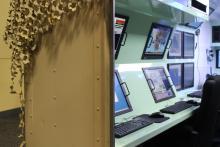
Boeing drone at Association of Unmanned Vehicle Systems Intl. convention in Washington. (CNSNews/Penny Starr)
(CNSNews.com) – Thousands of drones will join the 327 already flying in U.S. airspace over the next five years, according to the Federal Aviation Administration’s 2013 Aerospace Forecast, which called the unmanned vehicles “the most dynamic growth sector within the aviation industry.”(See 2013_Forecast.pdf)
An earlier FAA forecast estimated that 30,000 drones would be operating in U.S. airspace by 2020, according to an FAA spokesperson, but the current forecast predicts 7,500 drones in operation by 2018.
“We believe that the civil UAS (unmanned aircraft systems) markets will evolve within the constraints of the regulatory and airspace requirements,” a statement provided to CNSNews.com says. “Once enabled, we estimate roughly 7,500 commercial s[mall] UAS would be viable at the end of five years,” the statement says.
The FAA is ramping up to meet a congressional mandate to integrate drones into the National Air Space (NAS) by September 2015.
That’s when the FAA, which is in charge of testing and licensing drones, hopes to grant initial permission to private entities such as energy companies, news organizations, filmmakers and researchers to launch their own drones.
In anticipation, scores of unmanned aircraft filled up air space in the exhibit hall at the Washington Convention Center on Tuesday as exhibitors displayed their products and promoted their causes at the Association for Unmanned Vehicle Systems International convention.
Drones will be “a huge industry in the future,” predicted New Jersey resident Michael Henderson, part of the Mid-Atlantic Aviation Partnership, one of dozens of similar groups vying for six test sites to be selected by the FAA
There were 25 applicants from 24 states competing for the FAA-certified sites as of May 13, according to the FAA. Henderson said he hopes a joint effort by New Jersey and Virginia under the auspices of the Virginia Polytechnic Institute and State University will be named one of the finalists. (See UAS_testsite_map.pdf)
The test sites are part of FAA’s compliance with the FAA Modernization and Reform Act of 2012, which “requires the (FAA) Secretary to develop a plan to accelerate safely the integration by September 30, 2015, of civil unmanned aircraft systems (UASes, or drones) into the national airspace system.”
The law also “requires the FAA Administrator to establish a pilot program to integrate drones into the national airspace system at six test ranges meeting specified criteria.”
In addition, the law calls on the FAA to “designate permanent areas in the Arctic where small drones may operate 24 hours per day for research and commercial purposes.”
In February, CNSNews.com reported that some members of Congress had concerns about drones violating Americans’ privacy and civil liberties.

Neany Inc. demonstrates drone control base at convention in D.C. (CNSNews/Penny Starr)
“Safe integration of UAS [drones] involves gaining a better understanding of operational issues, such as training requirements, operational specifications and technology considerations,” FAA said in a statement.
“Because they are inherently different from manned aircraft, introducing UAS into the nation’s airspace is challenging for both the FAA and aviation community,” particularly because they must be integrated into a NAS “that is evolving from ground-based navigation aids to a GPS-based system in NextGen,” the FAA’s already troubled modernization program.
At a July 17 hearing before the House Subcommittee on Aviation, Department of Transportation Inspector General Calvin Scovel told members of Congress that “FAA’s difficulties in advancing NextGen and transforming the National Air Space stem from a number of underlying causes, including the lack of an executable plan and unresolved critical design decisions.” (See Scovel.pdf)
Source material can be found at this site.









